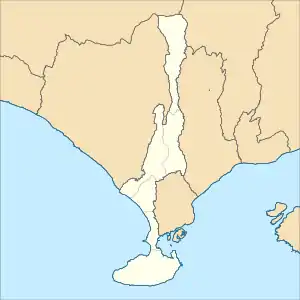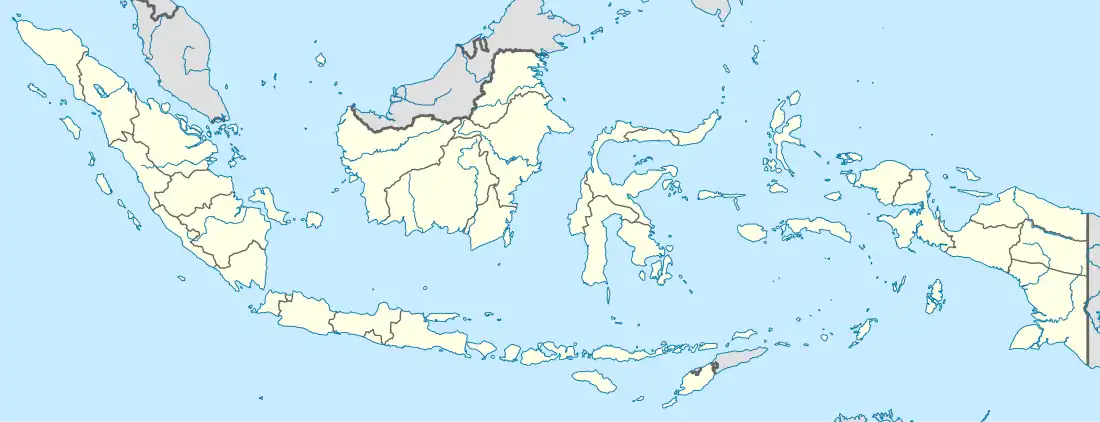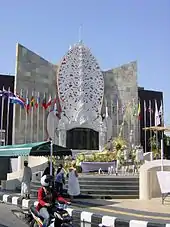Kuta
Kuta is a tourist area, administratively an urban village (kelurahan), and the capital of Kuta District, Badung Regency, southern Bali, Indonesia. Kuta is a part of the Denpasar metropolitan area and is situated 12 km (7.5 mi) south of Downtown Denpasar. It was originally known as a fishing village, it was one of the first towns on Bali to see substantial tourist development, and as a beach resort remains one of Indonesia's major tourist destinations. It is known internationally for its long sandy beach, varied accommodation, many restaurants and bars, and many renowned surfers who visit from Australia. It is located near Bali's Ngurah Rai Airport.
Kuta
| |
|---|---|
.jpg.webp) Kuta Beach | |
 Kuta Location in Badung Regency and Indonesia  Kuta Kuta (Indonesia) | |
| Coordinates: 8°44′S 115°10′E | |
| Country | Indonesia |
| Province | Bali |
| Regency | Badung |
| District | Kuta |
The Balinese Provincial Government have taken the view that the preservation of the Balinese culture, natural resources and wildlife are of primary importance in the development of the island. To this end they have limited tourist development to the peninsula on the extreme southern aspect of the island; Kuta beach is on the western side of this peninsula and Sanur is on the east. To the north of the peninsula no new tourist development is supposedly permitted.[1][2]
To the south, Kuta Beach extends beyond the airport into Jimbaran. Other nearby towns and villages include Seseh (6.4 nm), Denpasar (4.5 nm), Ujung (1.8 nm), Pesanggaran (2.0 nm), Kedonganan (2.9 nm), and Tuban (1.0 nm).
Administration
Badung Regency includes three districts with the name of Kuta:
- Kuta District (Kecamatan Kuta), which covers the villages of Kuta, Legian, Seminyak, Kedonganan, and Tuban. Kuta, Legian and Seminyak form a conurbation along the western side of the isthmus linking the Nusa Dua peninsula to the rest of Bali.
- South Kuta District (Kecamatan Kuta Selatan; includes Jimbaran and the whole of the Nusa Dua peninsula).
- North Kuta District (Kecamatan Kuta Utara; includes villages of Kerobokan Kelod, Kerobokan, Kerobokan Kaja, Tibubeneng, Canggu, and Dalung).

Kuta is now the center of an extensive tourist-oriented urban area that merges into the neighboring towns. Legian, to the north, is the commercial hub of Kuta and the site of many restaurants and entertainment spots. Most of the area's big beachfront hotels are in the southern section of Tuban.


Legian and Seminyak are northern extensions of Kuta along Jl. Legian and Jl. Basangkasa. They are somewhat quieter suburbs with cottage-style accommodations, where many of the expat crowd live. Also to the north are Petitenget, Berawa, Canggu, and Seseh — new and quieter continuations of Kuta's beach. They are easy to reach through Abian Timbul or Denpasar and Kerobokan. Several large hotels are located in this area: the Oberoi Bali, Hard Rock Hotel Bali, the Intan Bali Village, the Legian Bali in Petitenget, the Dewata Beach, and the Bali Sani Suites in Berawa.
History
Bali bombing memorial

After the first Bali Bombing in 2002 at Kuta, which killed 202 people including 88 Australians,[3] a permanent memorial was built on the site of the destroyed Paddy's Pub on Legian Street. (A new bar, named "Paddy's: Reloaded", was reopened further along Legian Street.) The memorial is made of intricately carved stone, set with a large marble plaque, which bears the names and nationalities of each of those killed. It is flanked by the national flags of the victims. The monument is well-maintained and illuminated at night.
The memorial was dedicated on 12 October 2004, the second anniversary of the attack. The dedication included a Balinese Hindu ceremony and the opportunity for mourners to lay flowers and other offerings. The Australian ambassador and Indonesian officials attended the ceremony as most of the victims were Australians.[4][5]
Kuta Beach
The beach has been notable since the early 1970s. Kuta (koo-tah) beach is also known as Sunset Beach, as opposed to the Sunrise Beach, another name for Sanur Beach. Luxury resorts, restaurants, and clubs are located along the beach.[6]
In 2011, a two-meter white sandstone fence, built in a Balinese architecture style, was built along the road to block the sand from blowing to the cafes and restaurants. The project cost Rp.4 billion ($0.47 million). Some tourists dislike it as it is considered to be blocking the beach view, while others believe the wall helps dampen the sounds from the congested traffic on the adjacent street.[7] To make the beach cleaner, as of late August 2011, vendors are prohibited from selling food on the beach, but they are still allowed to sell beverages and souvenirs.[8]
The annual monsoon season in the region often results in trash and plastic waste washing up on the shore. Locals and tourists volunteer to clean the waste.[9]
Tourism
Kuta is well known in Bali for being a cheap tourist destination for Australians due to its close proximity.
Popular culture
Kuta is mentioned in "I've Been To Bali Too", the single by Australian folk-rock band Redgum from their 1984 album Frontline. It is also home to an Indonesian punk rock band Superman Is Dead, most famous for its English song "Kuta Rock City".[10][11]
References
- ANTARA. "Membentengi Kelestarian Alam di Bali dengan Ritual Sakral". gaya hidup. Archived from the original on 2018-12-23. Retrieved 2018-12-22.
- www.gesuri.id. "Pemprov Bali Tetapkan Biaya Kontribusi bagi Wisatawan". gesuri.id/ (in Indonesian). Archived from the original on 2018-12-23. Retrieved 2018-12-22.
- "Sydney Morning Herald". Sydney Morning Herald. 2005. Archived from the original on 12 June 2018. Retrieved 17 May 2016.
- "Bom Bali 2002: Kebiadaban Teroris dan Duka Para Korban". tirto.id (in Indonesian). Archived from the original on 2018-12-23. Retrieved 2018-12-22.
- ABC (2018-10-12). "Korban Bom Bali di Australia Berusaha Menemukan Kedamaian 16 Tahun Setelah Kejadian". Tempo. Archived from the original on 2018-12-23. Retrieved 2018-12-22.
- Tugino (August 26, 2012). "Daftar Nama Pantai di Indonesia" (in Indonesian). Blogspot. Archived from the original on 10 April 2014. Retrieved 10 November 2012.
- Nurhayati, Desy (3 August 2011). "Kuta wall 'ruins the beach view'". The Jakarta Post. Archived from the original on 2015-04-30. Retrieved 2021-11-29.
- "Famous Kuta Beach free from food vendors". September 16, 2011. Archived from the original on September 19, 2012. Retrieved September 16, 2011.
- "18 tons of trash collected in three-day coastal cleanup at Kuta beach". The Jakarta Post. Archived from the original on 2020-10-30. Retrieved 2021-01-04.
- CoconutsBali (2017-08-10). "'I've Been to Bali Too': 80s Aussie anthem makes viral comeback as netizens reminisce about the island's good ol' days (VIDEO) | Coconuts Bali". Coconuts. Archived from the original on 2018-12-23. Retrieved 2018-12-22.
- "Balinese Rockers versus Australian Bogans". Roads & Kingdoms. 2014-08-19. Archived from the original on 2018-12-23. Retrieved 2018-12-23.